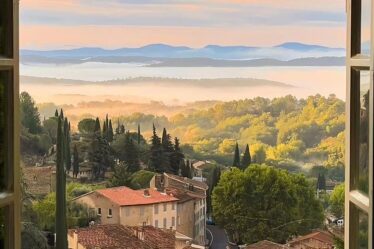Iceland, a Nordic island nation, is known for its dramatic landscapes, volcanoes, geysers, hot springs, and lava fields. The following is a detailed travel guide to help you plan your trip to the Land of Fire and Ice.
Best Time to Visit
The best time to visit Iceland depends on your preferences for weather and activities.
Summer (June – August): This is the peak season, with mild temperatures, long days, and vibrant green landscapes. Ideal for outdoor activities like hiking, camping, and wildlife watching. This is also the time for the Midnight Sun, which can be a unique experience.
Winter (December – February):This is the time for Northern Lights enthusiasts. Expect shorter days and colder temperatures, but also stunning snow-covered landscapes and frozen waterfalls. Some roads might be closed, limiting access to certain areas.
Shoulder Seasons (Spring: April – May; Autumn: September – November):These months offer fewer tourists, lower prices, and decent weather with occasional rain or snow. You can still enjoy outdoor activities and might even catch the Northern Lights in autumn.
Getting to Iceland
By Air: Keflavík International Airport (KEF) is the main international gateway to Iceland, located about 50 kilometers southwest of Reykjavík. Major airlines such as Icelandair, WOW Air, and Delta offer direct flights from several European and North American cities.
By Sea:Smyril Line operates a ferry service between Denmark, the Faroe Islands, and Seyðisfjörður in East Iceland. The journey takes around 48 hours and offers an opportunity to bring your own vehicle.
Getting Around Iceland
Car Rental: Renting a car is the most popular and flexible way to explore Iceland. Choose from a variety of car rental agencies, but make sure to book in advance, especially during peak season. Consider renting a 4×4 if you plan to drive on gravel roads or explore the Highlands.
Bus: The public bus system, Strætó, serves Reykjavík and other main towns. For rural areas, check out the long-distance bus network operated by various companies.
Guided Tours:Numerous tour operators offer group and private tours, ranging from day trips to multi-day adventures. This can be a convenient option if you prefer not to drive or want a local expert to guide you.
Biking:Cycling can be a great way to explore Iceland, but be prepared for challenging terrain and weather conditions.
Top Attractions
1. Golden Circle:A popular day trip from Reykjavík, this route includes Thingvellir National Park, Geysir geothermal area, and Gullfoss waterfall.
2. Reykjadalur Hot Springs: A short hike near Hveragerði leads to this geothermal river, where you can soak in the naturally heated water.
3. Vatnajökull National Park: Home to Europe’s largest glacier, Vatnajökull, this park offers ice caves, glacier hikes, and the stunning Jökulsárlón Glacier Lagoon.
4. Snæfellsnes Peninsula:Often called “Iceland in Miniature”, this area showcases diverse landscapes, including volcanic craters, lava fields, and the iconic Kirkjufell mountain.
5.Mývatn: A geothermal area in North Iceland with unique volcanic formations, hot springs, and a rich birdlife.
6. Blue Lagoon: A famous geothermal spa located near Keflavík Airport, known for its milky-blue waters and silica mud.
7. Reykjanes Peninsula:Home to the famous Bridge Between Continents, this area features lava fields, black sand beaches, and the Reykjanes Lighthouse.
8. Westfjords: A remote and rugged region known for its dramatic fjords, bird cliffs (such as Látrabjarg), and the scenic Dynjandi waterfall.
Accommodations
Iceland offers various accommodation options, from budget to luxury:
-Hotels:Reykjavík and other major towns have a good selection of hotels, from budget to high-end.
Guesthouses:These are smaller, often family-run establishments that provide a more personal experience.
Hostels: Budget-friendly hostels are available throughout the country, often with shared facilities.
FarmStays: Experience Icelandic rural life by staying at a farm, which often offers guest rooms or cottages.
Campsites:Camping is a popular option during the summer months, with numerous campsites available across the country. Be sure to follow the rules and only camp in designated areas.
Food and Restaurants
Icelandic cuisine is known for its fresh seafood, lamb, and dairy products. Some must-try dishes include:
Plokkfiskur: A traditional fish stew made with white fish, potatoes, onions, and a creamy sauce.
Hangikjöt:Smoked lamb, often served during festive occasions.
Skyr:A thick, yogurt-like dairy product, enjoyed as a dessert or snack with fruit and granola.
Kjötsúpa:A hearty lamb soup with vegetables, perfect for warming up on a cold day.
Restaurant options range from casual cafes to fine dining establishments. Reykjavík has the most diverse selection, but you’ll also find good eateries in other towns and along the Ring Road. Be aware that dining out in Iceland can be expensive.
Safety and Tips
– Iceland is considered one of the safest countries in the world, with low crime rates and friendly locals. However, it’s always a good idea to take basic precautions and secure your belongings.
– Weather in Iceland can be unpredictable, so pack layers and waterproof clothing to be prepared for sudden changes.
– When driving, be aware of gravel roads, single-lane bridges, and potential road closures, especially in winter. Always follow speed limits and road signs.
– Off-road driving is illegal in Iceland and can result in heavy fines. Stick to marked roads and designated parking areas.
– Be respectful of the fragile nature and avoid walking on moss or other delicate vegetation. Follow marked trails and obey warning signs near geothermal areas and other natural attractions.
– To save on costs, consider shopping for groceries and preparing your own meals, and fill up your water bottle with tap water, which is safe to drink and of high quality.
By following this detailed travel guide, you’ll be well-prepared to explore the stunning landscapes and unique experiences that Iceland has to offer. Enjoy your trip to the Land of Fire and Ice!


